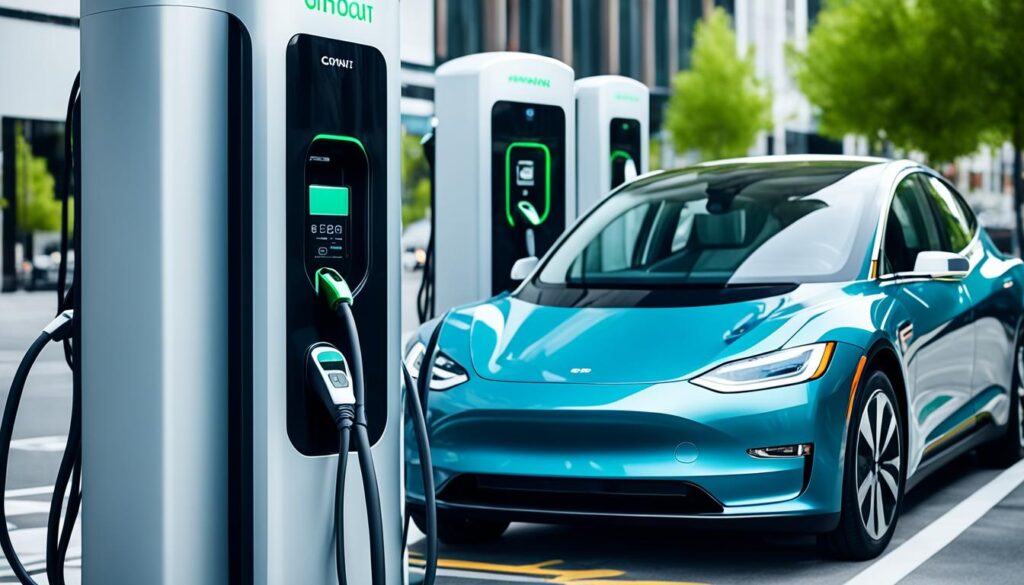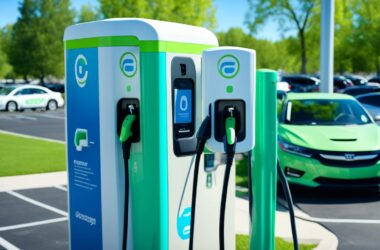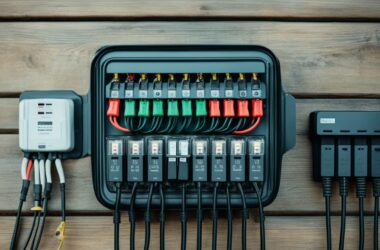Running a cable across pavement to charge an electric vehicle is a common challenge for those who don’t have a driveway. It is important to understand the legal obligations and ensure the safety of both the vehicle owner and the public. According to local government guidelines, it is usually permitted to charge an EV on a public road as long as it doesn’t obstruct the footway or any access areas. However, trailing a cable across the road is not allowed, even with a cable protector. It is essential to park as close to your home as possible and take precautions to avoid creating trip hazards. Alternative options for charging an EV without a driveway include using public charging infrastructure or applying for permission to install a charging point in a block of flats.
Key Takeaways:
- Charging an electric vehicle on a public road is usually allowed, as long as it doesn’t obstruct footways or access areas.
- Trailing a cable across the road, even with a cable protector, is not permitted.
- Park as close to your home as possible to minimize the need for trailing cables across the pavement.
- Consider alternative options such as using public charging infrastructure or applying for permission to install a charging point in a block of flats.
- Ensure the safety of the public and avoid creating trip hazards when charging an EV without a driveway.
How Much Does it Cost to Charge an Electric Car at Home?
The cost of charging an electric car at home depends on several factors, including your electricity tariff and the battery capacity of your vehicle. On average, the battery capacity of an EV in the UK is around 40kWh. The current average cost per kWh for domestic electricity in the UK is approximately 34p.
To calculate the cost of charging your EV, you can multiply the battery capacity by the cost per kWh. For example, a 40kWh battery would cost £13.60 to charge.
Compared to the cost of filling a petrol tank, which can be up to £100, charging an EV at home is considerably cheaper.
Calculating the cost to charge your electric car at home is a straightforward process. Let’s break it down:
- Determine your battery capacity. This information can usually be found in your vehicle’s owner manual or specifications.
- Check your electricity tariff. Find out the cost per kWh of domestic electricity from your energy provider.
- Multiply the battery capacity by the cost per kWh to calculate the total cost of charging your EV.
It’s important to consider the cost of charging your electric car at home as part of your overall budget. Understanding the financial implications will help you make informed decisions about your energy consumption.
Factors Affecting Charging Costs
While the average battery capacity and electricity tariff provide a reference point, it’s essential to consider additional factors that can influence charging costs:
- Electricity Tariff Structure: Different electricity tariffs may have varying rates depending on the time of day, seasons, or usage. Choosing the right tariff can help optimize cost savings.
- Charging Efficiency: Charging efficiency can vary between different EV models and charging equipment. Some loss of energy occurs during the charging process, affecting the overall cost.
- Charging Frequency: How often you need to charge your EV will impact your monthly energy consumption and cost. Daily commuting or long trips may require more frequent charging.
By considering these factors, you can get a more accurate estimate of the cost to charge your electric car at home.
Can You Charge an Electric Car Across a Pavement?
Trailing a power cable from your house to your car parked on the street is generally permitted, as long as it doesn’t obstruct the footway or any access areas. However, it is not allowed to trail a cable across the road, even with a cable protector. If you decide to use an extension cord for charging your EV, make sure it is suitable for outdoor use and lay the cable flat across the pavement. It is important to create no obstruction and ensure the safety of both pedestrians and the public. Using a cable protector can help minimize the risk of accidents and keep pavement-trailing cables safe.
Avoiding Obstructions and Ensuring Safety
- Park your EV as close to your home as possible to minimize cable length.
- Use an outdoor-rated extension cord that is long enough to reach your vehicle.
- Place the extension cord flat across the pavement, using cable protectors if necessary.
- Ensure that the power cable does not create a trip hazard for pedestrians.
- Consider seeking permission to install a dedicated EV charging point near your property.
By following these guidelines, you can charge your electric car on the street without causing obstructions or compromising safety.

Benefits of Using a Cable Protector
Using a cable protector is crucial when charging your EV on the street to safeguard both the pavement and the charging cable. Here are a few key benefits:
Protection: A cable protector shields the charging cable from damage caused by vehicles, pedestrians, or adverse weather conditions.
Safety: By preventing the cable from being a trip hazard, a cable protector ensures the safety of pedestrians and reduces the risk of accidents.
Durability: Investing in a high-quality cable protector can extend the lifespan of your charging cable, saving you money on replacements.
Visibility: Some cable protectors feature reflective markings, increasing visibility and reducing the risk of accidental damage.
Convenience: Cable protectors are easy to install and remove, allowing for hassle-free charging on the street.
By using a cable protector, you can charge your electric car safely while minimizing the chances of cable damage or accidents.
Charging an Electric Car in a Block of Flats
Charging an electric car in a block of flats can pose some challenges, but there are solutions available. If you own a flat and have a dedicated parking spot, you have the option to install an EV charging point. However, it is crucial to obtain permission from the freeholder or managing agent before proceeding with the installation. Speaking to your landlord is essential to explore the available options for charging your EV in a block of flats.
Fortunately, there is government support for EV charging in rented properties. The Office for Zero Emission Vehicles (OZEV) provides grants and legal assistance to both landlords and renters who wish to install charging points in rented properties. This support aims to encourage the adoption of electric vehicles and make charging more accessible.
If you don’t have the ability to install a charging point outside your flat, it is recommended to contact your landlord and discuss the possibility of installing EV charging infrastructure. With the available support and grants, your landlord may be open to the idea of providing EV charging facilities in the building.
Installing EV charging points in blocks of flats can offer numerous benefits, such as convenience for residents who own electric cars and a greener and more sustainable living environment. By collaborating with your landlord and taking advantage of the government support, you can contribute to the growth of EV infrastructure and enhance the EV ownership experience for yourself and others.
Government Support for EV Charging in Rented Properties
“The government’s Office for Zero Emission Vehicles (OZEV) provides grants and legal assistance to landlords and renters who want to install charging points in rented properties.”
Benefits of Installing EV Charging Points in Blocks of Flats
- Convenience for residents who own electric cars
- Contribution to the growth of EV infrastructure
- Enhanced sustainability of the living environment
By working together and embracing the opportunities for EV charging in blocks of flats, we can make electric vehicle ownership more accessible and environmentally friendly.
Using Public Charging Infrastructure
If you don’t have the ability to install a charging point outside your property, utilizing public charging infrastructure can be a convenient option for charging your electric vehicle (EV). Public charging points are becoming increasingly available in various locations, providing EV owners with more options for charging their vehicles.
Supermarkets, shopping centers, service stations, and car parks are just a few of the places where you can find public charging points. Additionally, many employers are installing charging stations in their office car parks, allowing employees to charge their EVs while at work.
Take advantage of the growing network of charging points and plan your charging needs accordingly. Most electric vehicles now have a range of 200 miles or more, reducing the need for frequent charging. However, for those with long daily commutes, alternative charging options may need to be considered.
Charging your EV at public charging points while shopping or working not only provides convenient access to charging facilities but also takes advantage of the time spent on these activities. This allows you to make the most of your day and ensures your EV is topped up and ready to go when you need it.
Remember to check the availability of charging points before traveling to ensure you can charge your EV as planned. Various mobile apps and websites provide real-time information about the status and availability of public charging points, making it easier for you to plan your charging stops along your route.
Benefits of using public charging infrastructure:
- Convenient access to charging points in various locations
- Ability to charge your EV while shopping or working
- Reduced reliance on home charging options
- Increased flexibility when traveling
By utilizing public charging infrastructure, you can charge your electric vehicle conveniently, even without a charging point at your home or workplace.

Importance of Using a Cable Protector
When it comes to charging your electric vehicle on the street, the safety of pavement users should be a top priority. That’s where a cable protector for EV charging comes in. A cable protector is a crucial accessory that ensures the safe and secure placement of charging cables, minimizing the risk of accidents and injuries.
By using a cable protector, you create a barrier between the charging cables and pedestrians, protecting both the public and your charging equipment. These protectors are designed to withstand the weight of vehicles and have non-slip properties, ensuring they stay in place and don’t present a tripping hazard.
A cable protector also helps maintain the longevity of your charging cables. It shields them from damage caused by passers-by or adverse weather conditions such as rain or extreme temperatures. By investing in a high-quality cable protector, you extend the lifespan of your charging cables and reduce the need for costly replacements.
Overall, the benefits of using a cable protector for EV charging are clear: it ensures the safety of pavement users, protects your charging cables, and saves you money in the long run. It’s a small investment with significant returns in terms of safety and peace of mind.
Take a look at the image below to see what a cable protector looks like in action:
As you can see, a cable protector creates a secure pathway for the charging cables, preventing them from becoming a potential hazard on the pavement. It’s a simple yet effective solution to ensure the safety of everyone involved.
In the next section, we will explore the future of EV charging infrastructure and how it is evolving to meet the needs of those without driveways.
The Future of EV Charging Infrastructure
The future of EV charging infrastructure is shaping up to be promising, with increasing government support and a growing number of charging points. As electric vehicles gain popularity, there is a need for a reliable and accessible charging network to accommodate the increasing demand.
One of the key developments in the future of EV charging infrastructure is the plan to increase the number of rapid charge points in various locations, including residential areas. This expansion aims to make charging convenient for EV owners, particularly those without driveways. By strategically placing rapid charge points, EV owners can easily access fast charging facilities and reduce range anxiety.
An important aspect of the future of EV charging infrastructure is the upgrading of lamp columns for residential charging. Lamp column charging points are being modified to allow for easier installation of charging facilities in residential areas. This upgrade will provide EV owners living in urban settings or areas with limited space the opportunity to charge their vehicles conveniently near their homes.
With the projected growth in EV adoption, it is essential to provide a mix of charging facilities to meet the diverse needs of EV owners. The future infrastructure will include both fast and rapid charge points, enabling EV owners to choose the best-suited option for their charging requirements.
Government support plays a crucial role in the development of EV charging infrastructure. The government, along with local authorities, is actively working to promote the adoption of electric vehicles and enhance the charging network. Through grants and subsidies, they are encouraging the installation of charging points in public and private spaces, ensuring easy access for all EV owners.
Overall, the future of EV charging infrastructure holds great promise for the accessibility and convenience of charging for EV owners. Through increasing government support, the upgrading of lamp columns, and a growing number of charging points, the infrastructure aims to support the transition to electric vehicles and provide a reliable charging network for all.
Government Support for EV Charging Development
| Government Initiatives | Description |
|---|---|
| Grants for Charging Point Installation | The government provides financial assistance in the form of grants to support the installation of charging points in various locations, including residential areas. |
| Subsidies for Electric Vehicle Purchases | The government offers subsidies and incentives to encourage the purchase of electric vehicles, further promoting the adoption of cleaner transportation. |
| Partnerships with Local Authorities | The government collaborates with local authorities to identify key locations for charging infrastructure and work towards their successful implementation. |
Conclusion
Charging an electric vehicle when you don’t have a driveway can be challenging, but it is not impossible. Understanding your legal obligations and taking necessary precautions is essential for safe and efficient charging. Trailing a power cable across the pavement is usually permitted as long as it doesn’t create an obstruction or risk to pedestrians. However, trailing a cable across the road is not allowed.
Using a cable protector and exploring alternative charging options, such as public charging infrastructure or applying for permission to install a charging point, can help overcome the challenges of charging without a driveway. With the increasing availability and support for EV charging, the future looks promising for those without driveways to conveniently charge their electric vehicles.











Having read this I thought it was very informative. I appreciate you taking the time and effort to put this article together. I once again find myself spending way to much time both reading and commenting. But so what, it was still worth it!
I have read a few just right stuff here. Certainly price bookmarking for revisiting. I surprise how so much effort you place to make any such excellent informative web site.
Way cool, some valid points! I appreciate you making this article available, the rest of the site is also high quality. Have a fun.